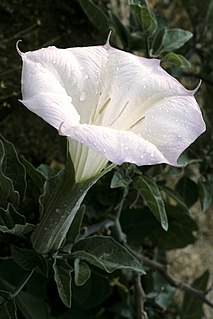
Datura is a genus of nine species of poisonous, vespertine-flowering plants belonging to the nightshade family Solanaceae. They are commonly known as thornapples or jimsonweeds, but are also known as devil's trumpets. Other English common names include moonflower, devil's weed, and hell's bells. All species of Datura are poisonous and potentially psychoactive, especially their seeds and flowers, which can cause respiratory depression, arrhythmias, fever, delirium, hallucinations, anticholinergic syndrome, psychosis, and even death if taken internally. Due to their effects and symptoms, they have occasionally been used not only as poisons, but also as hallucinogens by various groups throughout history. Traditionally, psychoactive administration of Datura species has often been associated with witchcraft and sorcery or similar practices in many cultures, including the Western world. Certain common Datura species have also been used ritualistically as entheogens by some Native American groups. Nonpsychoactive use of the plant is usually done for medicinal purposes, and the alkaloids present in plants of the Datura genus have long been considered traditional medicines in both the New and Old Worlds due to the presence of the alkaloids scopolamine and atropine, which are also produced by Old World plants such as Hyoscyamus niger, Atropa belladonna, and Mandragora officinarum.

Datura stramonium, known by the common names thorn apple, jimsonweed, devil's snare, devil's trumpet, or angel's trumpet, is a species of flowering plant in the nightshade family Solanaceae. Its likely origin was in Central America, and it has been introduced in many world regions. It is an aggressive invasive weed in temperate climates across the world. D. stramonium has frequently been employed in traditional medicine to treat a variety of ailments. It has also been used as a hallucinogen, taken entheogenically to cause intense, sacred or occult visions. It is unlikely ever to become a major drug of abuse owing to effects upon both mind and body frequently perceived subjectively as being highly unpleasant, giving rise to a state of profound and long-lasting disorientation or delirium with a potentially fatal outcome. It contains tropane alkaloids which are responsible for the psychoactive effects, and may be severely toxic.

Datura wrightii, commonly known as sacred datura, is a poisonous perennial plant species and ornamental flower of the family Solanaceae native to the Southwestern United States and northwestern Mexico. It is sometimes used as a hallucinogen due to its psychoactive alkaloids. D. wrightii is classified as an anticholinergic deliriant.
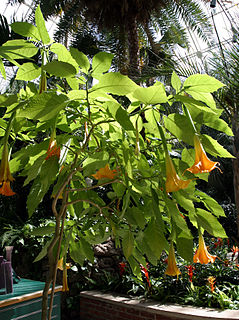
Brugmansia is a genus of seven species of flowering plants in the nightshade family Solanaceae. They are woody trees or shrubs, with pendulous flowers, and have no spines on their fruit. Their large, fragrant flowers give them their common name of angel's trumpets, a name sometimes used for the closely related genus Datura.

Marah oreganus, the Oregon manroot, coastal manroot or western wild-cucumber, is a common manroot of the northwest coast of the United States. It ranges from California north to Canada.

Datura metel is a shrub-like annual or short-lived, shrubby perennial, commonly known in Europe as Indian Thornapple, Hindu Datura, or Metel and in the U.S.A. as Devil's Trumpet or Angel's Trumpet. Datura metel is naturalised in all the warmer countries of the world - notably in India, where it is known by the ancient, Sanskrit-derived, Hindi name धतूरा (dhatūra) -from which the genus name Datura is derived. The plant is cultivated worldwide, both as an ornamental and for its medicinal properties, the latter being due to its tropane alkaloid content. Like its hardier and smaller-flowered relative Datura stramonium, it is now of widespread occurrence, although showing a preference for warmer climates and of more attractive appearance. Datura metel was first described by Carl Linnaeus in 1753, but few botanically correct illustrations were made until after the New World was settled. The original home of the plant is now known to have been somewhere in the Americas, probably the Greater Antilles. As late as 1992 it was still being claimed that the plant was "...native probably to the mountainous regions of Pakistan or Afghanistan westward..." While there now remains no doubt that the species originated in the New World, evidence is mounting that it was introduced to the Indian subcontinent - whether by human agency or some chance natural event is not known - at an early date preceding by far the arrival of the first European explorers in the Americas.

Datura innoxia, known as pricklyburr, recurved thorn-apple, downy thorn-apple, Indian-apple, lovache, moonflower, nacazcul, toloatzin, toloaxihuitl, tolguache or toloache, is a species of flowering plant in the family Solanaceae. It is more rarely called sacred datura, a common name which is applied more often to the closely related Datura wrightii. It is native to the Southwestern United States, Central and South America, and introduced in Africa, Asia, Australia and Europe. The scientific name is often cited as D. innoxia. When English botanist Philip Miller first described the species in 1768, he misspelled the Latin word innoxia (inoffensive) when naming it D. inoxia. The name Datura meteloides was for some time erroneously applied to some members of the species, but that name has now been abandoned.
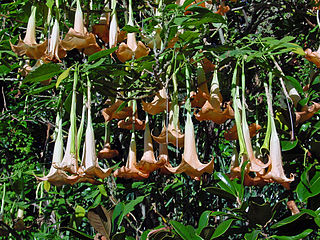
Brugmansia versicolor is a species of plant in the family Solanaceae, commonly known as “angel’s trumpets”. They are endemic to Ecuador. Since March 2014, they have been listed as Extinct in the Wild by the IUCN.

Datura leichhardtii is a species of thorn apple in the genus Datura. In 1844, Ludwig Leichhardt is said to have discovered this species in Australia. Ferdinand von Mueller gave it the name Datura leichhardtii when he published his first description of it in 1855.

Brugmansia suaveolens, Brazil's white angel trumpet, also known as angel's tears and snowy angel's trumpet, is a species of flowering plant in the nightshade family Solanaceae, native to south eastern Brazil, but thought to be extinct in the wild. Like several other species of Brugmansia, it exists as an introduced species in areas outside its native range. It is a tender shrub or small tree with large semi-evergreen leaves and fragrant yellow or white trumpet-shaped flowers.

Datura quercifolia, commonly known as the oak-leaved thorn-apple, is a small shrub in the genus Datura that is native to Mexico and the Southwestern United States. It grows equally well in dry and moist soils and requires full sun. It contains a mix of alkaloids that are poisonous and can be potentially lethal when ingested.
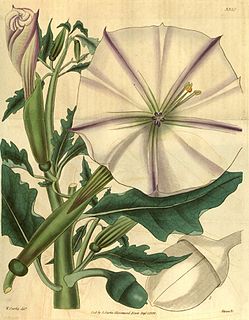
Datura ceratocaula is a species of Datura. It is weed-like in its natural habitat, but is grown in gardens and yards as an ornamental plant. The flower has a sweet smell. It is an annual plant that originally came from Mexico.
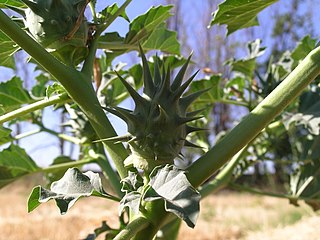
Datura ferox, commonly known as long spined thorn apple and fierce thornapple, as well as Angel's-trumpets, is a species of Datura. Like all such species, every part of the plant contains deadly toxins that can kill animals that ingest it. Its fruit, red-brown when ripe, has unusually long thorns or spikes.
Datura kymatocarpa is a species of Datura. It is native to Mexico and is an annual plant.
Datura lanosa is a species of Datura. Some contemporary botanists classify this plant not as a separate species, but as a variety of Datura wrightii or Datura innoxia.
Datura reburra is a species of Datura. It is an annual shrub that is grown as an ornamental plant.

Brugmansia arborea, the angel's trumpet, is a species of flowering plant in the family Solanaceae. The IUCN has classed Brugmansia arborea as Extinct in the Wild.

Brugmansia sanguinea, the red angel's trumpet, is a species of South American flowering shrub or small tree belonging to the genus Brugmansia in tribe Datureae of subfamily Solanoideae of the nightshade family Solanaceae. It has been cultivated and used as an entheogen for shamanic purposes by the South American Indians for centuries - possibly even millennia.
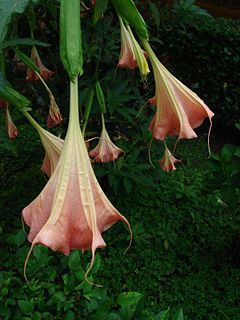
Brugmansia insignis is a South American species of angel's trumpet with large, fragrant flowers. The IUCN has listed this species as Extinct in the Wild, although like the other members of its genus its survival has been ensured by its popularity as an ornamental plant.

Brugmansia vulcanicola, is a shrub or small tree belonging to the genus Brugmansia of tribe Datureae in subfamily Solanoideae of the nightshade family, Solanaceae.

















